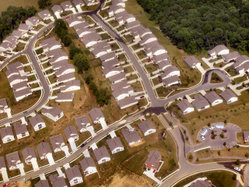This is a test
Community Collapse in the West
Page 1 of 6 pages 1 2 3 > Last » - Full Article
by Martin Pawley A third of a century ago world-renowned architecture critic Martin Pawley described the high toll our suburban, single-family way of life exacts upon upon social cohesion and community happiness.
A third of a century ago world-renowned architecture critic Martin Pawley described the high toll our suburban, single-family way of life exacts upon upon social cohesion and community happiness.
‘It’s no good Sir, they won’t answer.’
‘Never mind, keep trying.’
‘Community . . . Family . . . Society . . .’
Mr Leonard Kavanagh, described by neighbours as introverted, lay dead for between 12 and 18 months in his London flat before being found by the police yesterday ... ‘The people round here are not very friendly and the community tends to consist of people who have either been here donkey’s years and don’t want to know the neighbours and those who are workmen just passing through and using the area as digs. They don’t want to know the neighbours either,’ a woman in the newspaper shop opposite Mr Kavanagh’s flat said.
Report in The Times
10 February 1972
According to the Shorter Oxford English Dictionary the word ‘community’ has two basic meanings: the first is ‘the quality appertaining to all in common’, and the second is ‘a body of people organized into a political, municipal or social unity’. The fourth subsidiary meaning in the common quality line is given as ‘society, the social state’, and the example of usage, Steele’s ‘Marriage is the foundation of community’, which dates from 1712 and neatly links the already related terms ‘community’ and ‘society’ with the concept of the family. The word family itself derives from the two Latin words familia (household), and famulus (servant). As a definition the same dictionary offers ‘members of a household, parents, children and servants’, thereby embodying another central notion, the idea of inequality in rank. The word ‘society, notwithstanding its emergence under the heading of community, is itself defined as ‘a system or mode of life adopted by a body of individuals for the purpose of harmonious coexistence’. It derives from the Latin socius, meaning companion or ally, and in concise dictionaries is often fused with the meaning of community in such definitions as ‘society: any social community’. The generic term ‘social’ yields definitions which encompass all three terms, for example: ‘Living in companies, gregarious, interdependent,, existing only as a member of a compound organism’. Here the central ideas of community, family and society achieve their clearest expression and reveal their conventional relationship: ‘society’ is an organism consisting of ‘communities’ which are interdependent and made up in turn of ‘families’ which are the smallest accountable units of mutual obligation.
This then is the generally accepted meaning of terms whose interchangeability is seldom if ever scrutinized. The use of the term community, in particular, is almost a reflex amongst politicians and public figures of all kinds; priests, newspaper editorializers, columnists, popular moralists and law enforce¬ment agencies, all find it a useful word. The community is the majority, it is legitimate public opinion — even when its most pronounced characteristic is silence. That this organization of concentric rings of obligation and responsibility extends back into history is evident from the ancient terms used to define it. There is nothing new about community, it originates in those very conditions of scarcity, poverty and interdependence that obtained for the majority of the people of all nations until the very recent past. What is new is the bankruptcy of meaning that the term now possesses. The conditions of life have changed dramatically over the last thirty years for that very majority whose status as ‘the community’ remains largely un¬questioned today. So much so that to compare the definitions listed above with the reality of their late twentieth-century presence is simply to reveal glaring discrepancies. Let us begin with the smallest unit.
The family
The family, defined in 1545 as ‘the body of persons who live in one house or under one head, including parents, children and servants’, has shown a numerical decline ever since the gathering of reliable statistical information on the subject began over one hundred years ago. In 1861 the average number of persons per dwelling in England and Wales was over five, by 1966 it had sunk to under three, and this despite a doubling of the population during the same period. Parallelling this drop in household size, room occupancy itself has decreased in inverse proportion to over-all dwelling size, which is to say that the smallest households now provide the largest amount of space per person. Increases in dwelling size, such as that recorded in Germany between 1952 and 1970, when the average area rose from 55 square metres to 75 square metres, are almost all accounted for by the space demands of increasing numbers of consumer durables which diminishing households require. Thus the disappearance of domestic servants, in 1861 present in over twenty per cent of the households in England and Wales, has been more than compensated for by the rapid incorporation of increasing numbers of inanimate energy slaves doing the same jobs.
To restore the classic definition of the family to full consonance with these realities means to incorporate into it fewer people and more machines: to leave the machines out, as is customary, is to present the family as a small group of survivors from the populous Victorian household seen against a backdrop of dumb commodities which have nonetheless steadily increased their dominance of the available space. This trend towards a lower rate of occupancy is generally interpreted as an indication of improved living standards, which in some senses it is. But in an altogether more fundamental way it reflects the fact that people today spend much more time at home than they used to. Increased space standards are as much a response to the increased demands which people make upon their homes, as they are to a notional demand for better standards of comfort and hygiene. The passing of the old pattern of community life, the decline of small-scale public entertainments, the closure of the bars, cafes, restaurants and clubs of small towns and villages, all reflect an unprecedented emphasis on the home as a place to live as opposed to a place to stay. Part of the depopulation of the crowded nineteenth-century dwelling is a response to the more exacting demands of persons who increasingly regard their homes as their total environment. The demand for private gardens reflects the same change.
Page 1 of 6 pages 1 2 3 > Last » - Full Article
This is another test. It looks like comments work fine, after I fixed an error in the system.
interesting article!
Well, NY isn’t a much better alternative…just a bunch of people who don’t care about one another living on top of each other. That’s the beauty of an online community. You can get to know people that you would otherwise never talk to.










